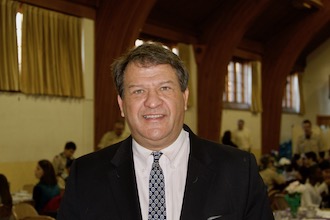County Executive George Latimer Gives Keynote Address at Martin Luther King Jr. Day Breakfast in Bronxville

By Westchester County Executive George Latimer
Jan. 24, 2018: There is a song that was popular over 25 years ago – perhaps you remember it – a soulful song by a man named Marc Cohn. The song is called “Walking in Memphis.”
It sets a scene of Memphis that the tourist board would love – the lyrics tell of the singer walking with his “feet on Beale Street, the home of the Delta Blues.” He sings of Rev. Green – Al Green of 1970s music fame. There was catfish on the table, gospel in the air; the singer saw the ghost of Elvis up on Union Avenue – followed him up to the gates of Graceland, and saw him walk through. WC Handy. Blue suede shoes. The wide Mississippi.
Several summers ago, I had the opportunity to be in Memphis. Yes, I walked on Beale Street, and, I confess, I went to Graceland. I saw the Peabody ducks march across the lobby of that grand hotel, and I saw the massive presence of FedEx headquarters at the Memphis airport.
And I visited something not mentioned in the song. I visited the Lorraine Motel.
If you’ve been there, you know that on that site has been built the National Civil Rights Museum, and it includes the motel as it looked on that fateful night in April 1968, when the Rev. Dr. Martin Luther King, Jr., with Rev. Ralph Abernathy, stayed during the Memphis sanitation men’s strike. Dr. King stepped out on the balcony of the Lorraine, and he stepped into history.
Dr. King had preached from a pulpit in Atlanta. He had accepted a Nobel Peace Prize in Oslo. He marched from the Edmund Pettus Bridge in Selma, Alabama. He wrote a letter from the Birmingham Jail. He stood on the steps of the Lincoln Memorial and looked out on the rows and rows of people on the Washington Mall and shared that he “had a dream.”
All of those stops along the road, in 39 short years, lead to Memphis, and the balcony of the Lorraine.
Walking through the Civil Rights Museum, the path takes you through all the dramatic moments of the Civil Rights movement 50 years past: Rosa Parks and the Montgomery bus boycott. The Little Rock Nine at Central High School. The lunch counter sit-in, Greensboro, North Carolina. Bull Connor’s dogs and fire hoses. Room after room after room – the stark reminders of how hard it was for human beings to receive the simple dignity and human rights every person deserves. Dignity granted by Almighty God, but denied by prejudice and hatred; years of slavery followed by years of Jim Crow. Protected by “law” in the Supreme Court, by Plessy v. Ferguson (1896) – “separate but equal.”
Lynchings and degradations done with the sanction of sheriffs and lawyers. Some churches – houses of God – that turned a blind eye, and at times, gave justification, to heinous acts of hatred.
This too was walking in Memphis.
On that night in April in 1968, I was a 14-year-old boy, living on the south side of Mount Vernon – the only white kid in an African American neighborhood. We had tired ourselves playing stickball earlier that day, and I was in my parents’ home on South 14th Avenue, consuming mass quantities of spaghetti, as hungry 14-year-old boys do. The breaking news came on the living room TV, followed by my father’s calls to watch the unfolding story. I “understood” that my black friends would be angry over the assassination of Dr. King. I “understood” it would be dangerous for me to go back outside that night.
I “understood” nothing, really, on that day. The 14-year-old George Latimer could not comprehend the magnitude of the pain and suffering; the magnitude of hope Dr. King generated; the magnitude of loss being felt from Memphis to Montgomery to Mount Vernon that night.
What the 14-year-old George Latimer could not grasp that night, the 64-year-old George Latimer can finally see clearly – seeing all the pieces put together during that walk in Memphis, leading up to the balcony of the Lorraine Motel.
When those Freedom Riders boarded the buses, they did so to free blacks from Jim Crow. What they were also doing was to free White America from its shackles of prejudice.
When those lunch counter protestors sat-in in Greensboro, NC, they sat in to assert the dignity of the black man; but in doing so they also were asserting the dignity of all men and women, for all mankind’s dignity, not just African dignity, but American dignity. The dignity of Italian Americans, demeaned as wops and dagos and considered all members of crime organizations. The dignity of Irish Americans demeaned as Micks, with signs that said “NINA” – no Irish need apply. They were asserting the dignity of those who are Jewish, those who are Native American, those who are Asian, those who are Hispanic, those who are Catholics, and those who are Buddhists, and those who are Muslims, and those who fall within any number of demographic descriptions.
The march from Selma to Montgomery asserted the right of black men and women to vote – to select their leaders – to govern themselves, but by doing so, they asserted that right for all men and women.
I heard, in the days after Dr. King’s assassination, a voice on the radio of the man who was our then-U.S. senator from New York. He said, “No one can be certain who next will suffer from some senseless act of bloodshed.” In the next 60 days, we found out who did, in fact, suffer next. That voice belonged to Sen. Robert F. Kennedy. And yet, the violence of those days did not deter the dream.
We are here today remembering the life of Dr. King, not his death. But he was not just a dreamer – he was a doer. The bravery he showed, in the face of constant physical threats, is a model for all of us; to show bravery in standing up for beliefs and principles, even if they are unpopular. Especially if they are unpopular.
Dr. King preached non-violence, but he did not preach passivity and timidity. He dreamt that there would be a better day for all of us, but he worked every day of his life to achieve that better day, knowing that good works and faith go hand in hand.
For those of us in the Christian faith, as joyous as Christmastime is – the birth of Christ – the greater celebration is the rising of Christ after his crucifixion, his triumph over death that we celebrate at Easter.
The ideas and the dreams of Dr. King have triumphed over his death. They have triumphed over those who set fire to the Freedom Rider buses; they have triumphed over those who taunted the Little Rock Nine and triumphed over those who stood in the schoolhouse door at Ole Miss and Alabama. The ideas have triumphed over Bull Connor’s dogs and over those who placed the firebomb in the church on Sixteenth Street that killed little girls in 1963.
Rosa Parks now has her seat--in heaven. And we here on Earth must continue forward to complete the unfinished business of Dr. King’s legacy.
As the song concludes:
Put on my blue suede shoes
And I boarded the plane ...
In the middle of the pouring rain.
Pictured here: George Latimer at the MLK Day breakfast at The Reformed Church of Bronxville last week.
Photo by A. Warner
Editor's note: As a public service, MyhometownBronxville publishes press releases from local institutions and legislators. MyhometownBronxville does not fact-check statements in press releases and any opinions expressed therein do not necessarily reflect the thinking of its staff.
Government & History Directory
Bronxville is a quaint village (one square mile) located just 16 miles north of midtown Manhattan (roughly 30 minutes on the train) and has a population of approximately 6,500. It is known as a premier community with an excellent public school (K-12) and easy access to Manhattan. Bronxville offers many amenities including an attractive business district, a hospital (Lawrence Hospital), public paddle and tennis courts, fine dining at local restaurants, two private country clubs and a community library.
While the earliest settlers of Bronxville date back to the first half of the 18th century, the history of the modern suburb of Bronxville began in 1890 when William Van Duzer Lawrence purchased a farm and commissioned the architect, William A. Bates, to design a planned community of houses for well-known artists and professionals that became a thriving art colony. This community, now called Lawrence Park, is listed on the National register of Historic Places and many of the homes still have artists’ studios. A neighborhood association within Lawrence Park called “The Hilltop Association” keeps this heritage alive with art shows and other events for neighbors.
Bronxville offers many charming neighborhoods as well as a variety of living options for residents including single family homes, town houses, cooperatives and condominiums. One of the chief benefits of living in “the village” is that your children can attend the Bronxville School.
The Bronxville postal zone (10708, known as “Bronxville PO”) includes the village of Bronxville as well as the Chester Heights section of Eastchester, parts of Tuckahoe and the Lawrence Park West, Cedar Knolls, Armour Villa and Longvale sections of Yonkers. Many of these areas have their own distinct character. For instance, the Armour Villa section has many historic homes and even has its own newsletter called “The Villa Voice” which reports on neighborhood news.
Link to Village of Bronxville One Square Mile Monthly Newsletter
Village of Bronxville Administrative Offices
337-6500
Open 9:00am - 4pm excluding holidays and weekends
Bronxville Police Department
337-0500
Open 24 hours
Bronxville Parking Violations
337-2024
Open 9:00am - 4pm excluding holidays and weekends
Bronxville Fire Deparment
793-6400












